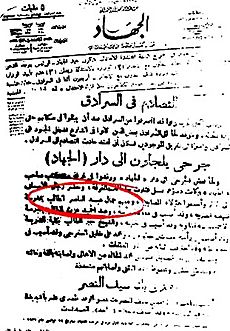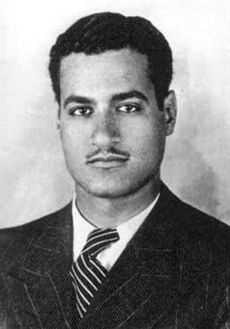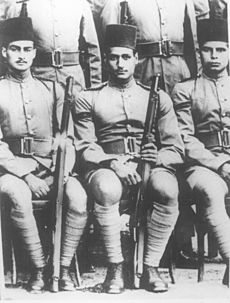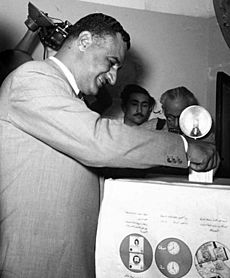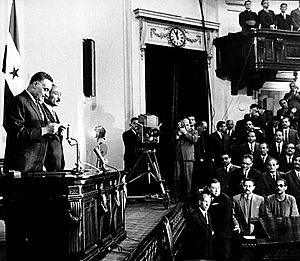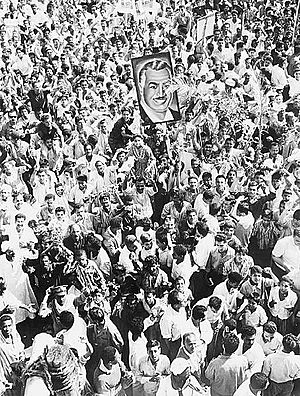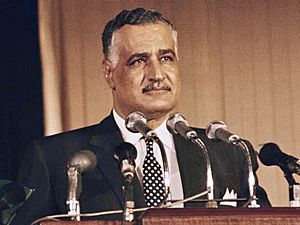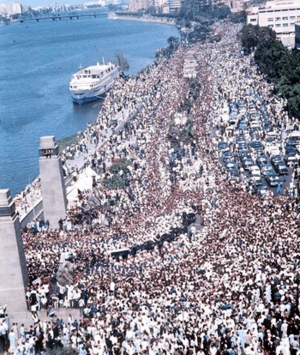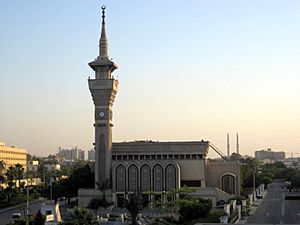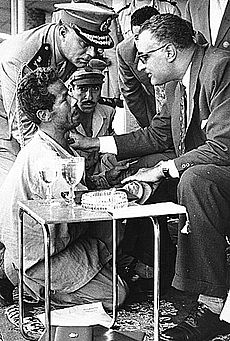Gamal Abdel Nasser facts for kids
Quick facts for kids
Gamal Abdel Nasser
|
|
|---|---|
| جمال عبد الناصر | |

President Nasser in 1962
|
|
| 2nd President of Egypt | |
| In office 23 June 1956 – 28 September 1970 |
|
| Prime Minister |
See list
|
| Vice President |
See list
|
| Preceded by | Mohamed Naguib |
| Succeeded by | Anwar Sadat |
| 31st Prime Minister of Egypt | |
| In office 19 June 1967 – 28 September 1970 |
|
| President | Himself |
| Preceded by | Mohamed Sedki Sulayman |
| Succeeded by | Mahmoud Fawzi |
| In office 18 April 1954 – 29 September 1962 |
|
| President | Mohamed Naguib Himself |
| Preceded by | Mohamed Naguib |
| Succeeded by | Ali Sabri |
| In office 25 February 1954 – 8 March 1954 |
|
| President | Mohamed Naguib |
| Preceded by | Mohamed Naguib |
| Succeeded by | Mohamed Naguib |
| Deputy Prime Minister of Egypt | |
| In office 8 March 1954 – 18 April 1954 |
|
| Prime Minister | Mohamed Naguib |
| Preceded by | Gamal Salem |
| Succeeded by | Gamal Salem |
| In office 18 June 1953 – 25 February 1954 |
|
| Prime Minister | Mohamed Naguib |
| Preceded by | Sulayman Hafez |
| Succeeded by | Gamal Salem |
| Minister of the Interior | |
| In office 18 June 1953 – 25 February 1954 |
|
| Prime Minister | Mohamed Naguib |
| Preceded by | Sulayman Hafez |
| Succeeded by | Zakaria Mohieddin |
| Chairman of the Revolutionary Command Council | |
| In office 14 November 1954 – 23 June 1956 |
|
| Preceded by | Mohamed Naguib |
| Succeeded by | Himself as President |
| Secretary General of the Non-Aligned Movement | |
| In office 5 October 1964 – 8 September 1970 |
|
| Preceded by | Josip Broz Tito |
| Succeeded by | Kenneth Kaunda |
| Chairman of the Organisation of African Unity | |
| In office 17 July 1964 – 21 October 1965 |
|
| Preceded by | Haile Selassie I |
| Succeeded by | Kwame Nkrumah |
| Personal details | |
| Born |
Gamal Abdel Nasser Hussein
15 January 1918 Alexandria, Sultanate of Egypt |
| Died | 28 September 1970 (aged 52) Cairo, United Arab Republic |
| Cause of death | Heart attack |
| Resting place | Gamal Abdel Nasser Mosque |
| Political party | Arab Socialist Union |
| Spouse |
Tahia Kazem
(m. 1944) |
| Children | Five, including Khalid Abdel Nasser |
| Profession | Military officer, and later politician |
| Signature |  |
| Military service | |
| Allegiance | |
| Branch/service | |
| Years of service | 1938–1952 |
| Rank | |
| Battles/wars | 1948 Arab–Israeli War |
Gamal Abdel Nasser Hussein (15 January 1918 – 28 September 1970) was a famous Egyptian politician. He served as the second president of Egypt from 1954 until he passed away in 1970. Nasser led the Egyptian revolution of 1952, which brought big changes to Egypt. He was formally elected president in June 1956.
Nasser became very popular in Egypt and the Arab world after he took control of the Suez Canal Company. This led to the Suez Crisis, where Egypt faced attacks from Britain, France, and Israel. Nasser's political victory in this crisis made him a hero. People started calling for Arab unity under his leadership. This led to the creation of the United Arab Republic with Syria from 1958 to 1961.
In 1962, Nasser started many socialist changes and modern reforms in Egypt. Even with some difficulties, his supporters gained power in several Arab countries by 1963. He became involved in the North Yemen Civil War and later the larger Arab Cold War. He began his second term as president in March 1965.
After Egypt's defeat by Israel in the Six-Day War of 1967, Nasser resigned. However, huge public protests called for him to return, and he did. By 1968, Nasser became Prime Minister. He started the War of Attrition to try and get back the Sinai Peninsula from Israel. He also began to reduce the military's power in politics and introduced some political freedoms. After an important meeting of Arab leaders in 1970, Nasser had a heart attack and died. His funeral in Cairo was attended by millions, showing how much he was loved across the Arab world.
Nasser is still a very important figure in the Arab world. He is remembered for his efforts towards social justice, Arab unity, and modernizing Egypt. He also worked against colonialism. During his time as president, Egypt saw a cultural boom and started big projects like the Aswan Dam. Some people criticize Nasser for being too strict and for limiting freedoms. They also point to the military's strong role in government during his time.
Contents
- Gamal Abdel Nasser's Early Life
- Gamal Abdel Nasser's Military Career
- The Egyptian Revolution of 1952
- Gamal Abdel Nasser's Path to Presidency
- Taking Control of the Suez Canal
- Pan-Arabism and Socialism
- Modernizing Egypt and Internal Issues
- The Six-Day War
- Final Years as President
- Death and Funeral
- Gamal Abdel Nasser's Legacy
- Personal Life
- Writings
- Honours
- See also
Gamal Abdel Nasser's Early Life
Gamal Abdel Nasser Hussein was born in Alexandria, Egypt, on 15 January 1918. This was just before the Egyptian Revolution of 1919. His father worked for the postal service. His mother's family came from a different part of Egypt. Nasser had two younger brothers. His family believed in the "Arab notion of glory."
Nasser's family moved often because of his father's job. In 1924, he went to live with his uncle in Cairo to attend school. He wrote letters to his mother and visited her on holidays. In 1926, he found out his mother had died after giving birth to his third brother. This news was kept from him, and he later said it was a deep shock.
In 1928, Nasser moved to Alexandria to live with his grandfather. He later went to a private boarding school. Then he returned to Alexandria to live with his father and attend Ras el-Tin secondary school. It was here that he first got involved in politics. He joined a protest without knowing its exact purpose. The protest was against British rule in Egypt. Nasser was arrested and held for one night. He briefly joined a group called the Green Shirts in 1934. This time made him feel very strongly about Egyptian nationalism.
When his father moved to Cairo in 1933, Nasser joined him. He attended al-Nahda al-Masria school. He acted in school plays and wrote articles for the school paper. On 13 November 1935, Nasser led a student protest against British rule. Two protesters were killed, and Nasser was injured. This event was his first mention in the newspapers. The nationalist newspaper Al Gihad reported that Nasser led the protest.
Nasser's involvement in politics grew during his school years. He often missed classes because of it. He did not like the Anglo-Egyptian treaty of 1936. This treaty allowed British military bases to stay in Egypt. Despite his strong feelings, political unrest calmed down, and Nasser finished school.
Early Inspirations for Gamal Abdel Nasser
Nasser read a lot, especially at the National Library of Egypt. He read the Quran, the sayings of Muhammad, and biographies of leaders like Napoleon and Atatürk. He was very inspired by Egyptian nationalism. His teacher at the Royal Military Academy, Aziz al-Masri, also influenced him. Nasser later said that a novel called Return of the Spirit inspired him to start the revolution.
Gamal Abdel Nasser's Military Career
In 1937, Nasser wanted to join the Royal Military Academy. However, his police record from protests stopped him at first. He then started law school but quit after one semester. He really wanted a military career. He believed he needed help to get into the academy. He managed to meet a high-ranking official who sponsored his application. Nasser was accepted in late 1937.
At the academy, he met Abdel Hakim Amer and Anwar Sadat. These two became important helpers during his presidency. After graduating in July 1938, he became a second lieutenant. He was sent to Mankabad. Here, Nasser and his friends talked about how unhappy they were with corruption in Egypt. They wanted to overthrow the monarchy. Sadat later wrote that Nasser became their natural leader because he was energetic and clear-thinking.
In 1941, Nasser was sent to Khartoum, Sudan, which was part of Egypt. He returned to Egypt in 1942. In 1943, he became an instructor at the Cairo Royal Military Academy. In 1942, British soldiers surrounded King Farouk's palace. They forced the King to change his prime minister. Nasser saw this as a huge insult to Egypt. He felt ashamed that the Egyptian army did not react. He then started to form a group of young officers. They had strong nationalist feelings and wanted a revolution.
Gamal Abdel Nasser in the 1948 Arab–Israeli War

Nasser's first experience in battle was in Palestine during the 1948 Arab–Israeli War. He volunteered to serve but was not allowed by the Egyptian government. In May 1948, King Farouk sent the Egyptian army into Israel. Nasser served as an officer. He wrote about how unprepared the Egyptian army was.
Nasser was a deputy commander of Egyptian forces in the Faluja pocket. On 12 July, he was slightly wounded. By August, his group was surrounded by the Israeli Army. They refused to give up. Eventually, a deal was made, and Faluja was given to Israel. Nasser and his men became heroes for their bravery.
After the war, Nasser returned to his teaching job. He tried to work with the Muslim Brotherhood but found their religious goals did not match his nationalist ones. He kept some distance from them. Nasser was part of the Egyptian group that negotiated a ceasefire with Israel in 1949. He felt the terms were humiliating for Egypt.
The Egyptian Revolution of 1952
The Free Officers Movement
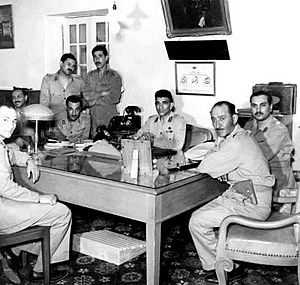
After returning to Egypt, Nasser was questioned about forming a secret group of officers. He denied it, and was released. This made him speed up his group's plans. After 1949, the group called themselves the "Association of Free Officers." They wanted freedom and dignity for Egypt. Nasser organized the group's main committee, which had fourteen men. Nasser was chosen as their leader.
In 1950, the Wafd Party won elections. The Free Officers saw them as a threat because they also wanted changes. But then, accusations of corruption against Wafd politicians appeared. This brought the Free Officers to the forefront. The group grew to about ninety members. Nasser felt they were not ready to act yet. For almost two years, he mostly recruited officers and shared secret news bulletins.
In October 1951, the government ended the unpopular Anglo-Egyptian treaty of 1936. This treaty allowed British military forces in the Suez Canal Zone. This move, and attacks on the British, put pressure on Nasser to act. In January 1952, Nasser and a friend tried to kill a royal general. They missed and wounded an innocent person instead.
The general was close to King Farouk. He was nominated to lead the Officer's Club. Nasser wanted the army to be independent from the king. The Free Officers chose Mohamed Naguib, a popular general, to run against him. Naguib won easily. The Free Officers used newspapers to share his victory and praise the army's nationalist spirit.
The 1952 Revolution Begins
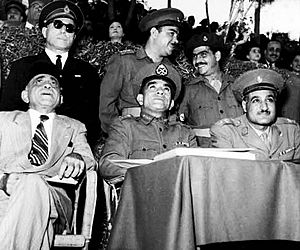
On 25 January 1952, British soldiers attacked a police station in Ismailia. Fifty Egyptian policemen were killed. This caused outrage and riots in Cairo, where 76 people died. After this, Nasser shared a six-point plan to end feudalism and British influence in Egypt. In May, Nasser learned that King Farouk knew about the Free Officers. He quickly planned to take over the government with loyal army units.
The Free Officers wanted to bring back democracy, not rule themselves. Nasser felt that a low-ranking officer like him would not be accepted by the people. So, he chose General Naguib to lead the coup. The revolution started on 22 July and was successful the next day. The Free Officers took control of government buildings and army headquarters. Nasser wore civilian clothes to avoid being recognized. He had told the American and British governments about his plans. They agreed not to help King Farouk. Nasser also agreed to let the king leave Egypt with respect.
On 18 June 1953, the monarchy was ended. The Republic of Egypt was declared, with Naguib as its first president. Nasser and the Free Officers expected to protect the people's interests. They wanted civilians to run the daily government. They asked former prime minister Ali Maher to lead a new civilian government. The Free Officers formed the Egyptian Revolutionary Command Council (RCC). Naguib was chairman, and Nasser was vice-chairman.
Maher thought Nasser's ideas, like ending the monarchy, were too extreme. He resigned on 7 September. Naguib became prime minister, and Nasser became deputy prime minister. In September, the Agrarian Reform Law was passed. Nasser saw this law as giving the RCC its own purpose and turning the coup into a revolution.
Gamal Abdel Nasser's Path to Presidency
Challenges with Naguib
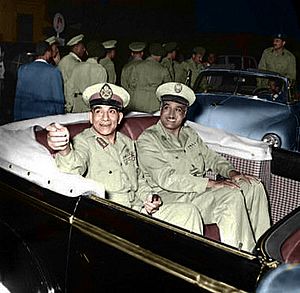
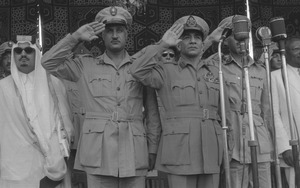
In January 1953, Nasser banned all political parties. He created a one-party system called the Liberation Rally. Nasser was its leader. He was the only RCC member who still wanted parliamentary elections by 1956. Naguib started to act more independently. He disagreed with some of the RCC's land reforms. He also got closer to older political groups. Nasser decided to remove him from power. In June, Nasser took control of the interior ministry. He pushed Naguib to finish ending the monarchy.
On 25 February 1954, Naguib resigned. Nasser accepted his resignation and put Naguib under house arrest. The RCC then announced Nasser as their chairman and prime minister. But a mutiny (rebellion) quickly followed. Soldiers demanded Naguib's return. Nasser was at first forced to agree. However, Nasser's supporters in the army ended the mutiny the next day. Hundreds of thousands of protesters, many from the Muslim Brotherhood, called for Naguib's return. Nasser agreed but delayed Naguib's return. This allowed him to promote Amer to lead the armed forces.
Nasser's security forces arrested thousands of people involved in the uprising. The RCC then pretended to end restrictions on old political parties. This was a trick to get people to oppose returning to the old ways. Workers, farmers, and small business owners protested. They did not want the old system back. Nasser then announced that the old parties would not return. Between April and June, many of Naguib's supporters in the military were arrested or fired. Nasser became the clear leader of Egypt.
Becoming Chairman of the RCC
On 26 October 1954, a member of the Muslim Brotherhood tried to kill Nasser. This happened while Nasser was giving a speech in Alexandria. He was celebrating the British military leaving Egypt. The gunman fired eight shots but missed Nasser. People panicked, but Nasser stayed calm and spoke louder.
The crowd cheered, and people across the Arab world were excited. The assassination attempt actually helped Nasser. When he returned to Cairo, he ordered a huge crackdown. Thousands of people were arrested, mostly from the Muslim Brotherhood. Naguib was removed from the presidency and put under house arrest. With his rivals gone, Nasser became the undisputed leader of Egypt.
Nasser needed more public support for his reforms. He gave speeches across the country. He also controlled the country's newspapers to prevent "rebellion." Famous Arab singers performed songs praising Nasser. Nasser himself planned this campaign. He started using terms like "Arab homeland" and "Arab nation" more often in his speeches. In January 1955, the RCC made him their president, waiting for national elections.
Nasser had secret talks with Israel in 1954–55. But he decided that peace with Israel was not possible. On 28 February 1955, Israeli troops attacked the Gaza Strip. Nasser felt his army was not ready to fight back. This made him look weak. So, he ordered a tighter blockade on Israeli ships using the Straits of Tiran. He also limited Israeli planes over the Gulf of Aqaba.
Around the same time, the Baghdad Pact was formed. This was an alliance of some countries allied with the UK. Nasser saw this as a threat to his goal of removing British influence in the Middle East. He felt he needed modern weapons for his military. When Western countries would not sell him weapons on good terms, Nasser turned to the Eastern Bloc. He made a big arms deal with Czechoslovakia in September. This deal helped balance power between Egypt and Israel. It also made Nasser seem like an Arab leader who stood up to the West.
Choosing Neutrality in the Cold War
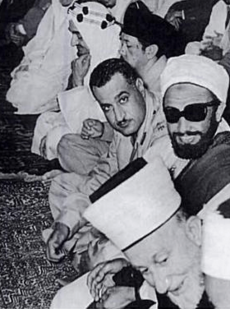
At the Bandung Conference in Indonesia in April 1955, Nasser was seen as the main representative of Arab countries. He was very popular there. He had visited Pakistan, India, and other countries before the conference. He also made a friendship treaty with India.
Nasser helped lead talks between different groups at the conference. These groups were pro-Western, pro-Soviet, and neutral. They discussed colonialism in Africa and Asia and how to achieve world peace during the Cold War. Nasser wanted a statement against military alliances. He also wanted support for independence in Tunisia, Algeria, and Morocco. He pushed for the Palestinian right of return and for UN resolutions on the Arab–Israeli conflict. He succeeded in getting support for these issues, especially from China and India.
After Bandung, Nasser officially adopted "positive neutralism." This idea came from leaders like Josip Broz Tito of Yugoslavia and Jawaharlal Nehru of India. It meant Egypt would not take sides in the Cold War. Nasser was welcomed by huge crowds when he returned to Egypt. His leadership and confidence grew greatly.
The 1956 Constitution and Presidency
Nasser's position in Egypt became much stronger. He gained almost total control over decisions, especially in foreign policy. In January 1956, a new Constitution of Egypt was written. It created a single-party system called the National Union (NU). Nasser said the NU would help achieve the revolution's goals. He wanted more citizens to join the NU to support his government. The NU would choose a presidential candidate for public approval.
Nasser's nomination and the new constitution were put to a public vote on 23 June. Both were approved by a huge majority. A 350-member National Assembly was created, with elections in July 1957. Nasser had the final say on all candidates. The constitution gave women the right to vote. It also banned discrimination based on sex and protected women at work. The RCC dissolved itself, and its members left the military to become civilians. Nasser began to remove his rivals from the original Free Officers. He gave important jobs to his closest friends.
Taking Control of the Suez Canal
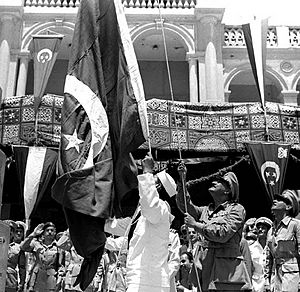
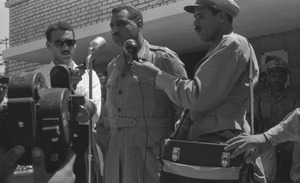
After Nasser officially took power, his policies clashed with the interests of Britain and France. France did not like his support for Algerian independence. Britain was upset by his actions against the Baghdad Pact. Also, Nasser's neutral stance in the Cold War and his arms deal with the Eastern Bloc worried the United States. On 19 July 1956, the US and UK suddenly stopped their offer to fund the Aswan Dam. They said Egypt's economy could not handle the project.
Nasser was very offended when he heard this news. He decided to take control of the Suez Canal Company. This company managed the waterway. Nasser announced this decision on 26 July 1956 in a speech in Alexandria. He said Egypt would use the canal's money to build the Aswan Dam. He criticized British control over the canal's profits. He said Egyptians had a right to control the waterway, especially since many Egyptians died building it. He promised to pay back all existing shareholders.
People cheered loudly when Nasser announced the nationalization. Across the Arab world, thousands celebrated. The US ambassador said the nationalization was very popular in Egypt. This event greatly increased Nasser's popularity. He became known as a leader for the common people in Egypt and beyond. This was a huge victory for his pan-Arab ideas. On the same day, Egypt closed the canal to Israeli ships.
The Suez Crisis
France and the UK, who owned most of the Suez Canal Company, saw this as a hostile act. Nasser knew nationalizing the canal would cause an international crisis. He thought there was an 80% chance of military action. In early October, the UN Security Council met. They passed a resolution recognizing Egypt's right to control the canal. This was as long as foreign ships could still pass through. Nasser thought the risk of invasion had dropped. However, the UK, France, and Israel secretly agreed to take over the canal and remove Nasser.
On 29 October 1956, Israeli forces entered the Sinai Peninsula. They quickly moved towards their targets. Two days later, British and French planes bombed Egyptian airfields. Nasser ordered the Egyptian Army to leave Sinai to defend the canal. He worried that if his tanks fought in Sinai, they would be cut off. Amer, his military commander, disagreed, but Nasser insisted. Nasser also ordered ships to be sunk in the canal to block it.
About 2,000 Egyptian soldiers were killed, and 5,000 were captured by Israel. Amer suggested asking for a ceasefire. Nasser refused, saying, "Nobody is going to surrender." Nasser took over military command. Despite the quick loss of Sinai, Nasser's popularity in Egypt and among Arabs remained strong. He gave out rifles to civilian volunteers. Many local groups formed to resist.
Nasser saw the city of Port Said as key to Egypt's defense. More troops and national guardsmen were sent there. Nasser and a colleague went to the canal zone to encourage the volunteers. When British and French forces landed in Port Said on 5–6 November, the local militia fought hard. About 750 to 1,000 Egyptians died in the battle.
The US government under President Dwight D. Eisenhower condemned the invasion. They supported UN resolutions for withdrawal and for a UN force in Sinai. Nasser praised Eisenhower for stopping the "conspiracy." By the end of December, British and French forces left Egypt. Israel left in March 1957. As a result of the crisis, Nasser put in place strict rules for foreigners. Many British, French, and Jewish people with foreign nationality were forced to leave. About 25,000 Jews left Egypt in 1956.
After the fighting, Nasser's political position was greatly strengthened. The invasion was seen as a failure, and attempts to remove him had failed. A British diplomat said the crisis made Nasser the clear leader of Egypt.
Pan-Arabism and Socialism
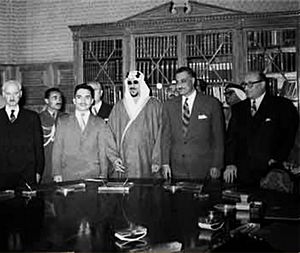
By 1957, pan-Arabism was very popular in the Arab world. Many Arabs saw Nasser as their leader. The Cairo-based radio station, Voice of the Arabs, spread Nasser's ideas. A historian wrote that "Nasser conquered the Arab world by radio." Egypt also sent skilled professionals, like teachers, to other Arab countries. Nasser had support from Arab nationalist groups across the region. His followers were called "Nasserites," though Nasser preferred "Arab nationalists."
In January 1957, the US introduced the Eisenhower Doctrine. This plan aimed to stop the spread of communism in the Middle East. Nasser was against communism, but his promotion of pan-Arabism was seen as a threat by pro-Western countries. The US tried to limit Nasser's influence. Also in January, Jordan joined a military pact with Egypt, Syria, and Saudi Arabia.
Relations between Nasser and King Hussein of Jordan worsened. Hussein accused Nasser of trying to overthrow him. Nasser then criticized Hussein on Cairo radio. Relations with King Saud of Saudi Arabia also became difficult. Saud feared Nasser's popularity in Saudi Arabia. Despite opposition from some governments, Nasser remained popular among the people in Arab countries.
By the end of 1957, Nasser took control of all remaining British and French businesses in Egypt. These included industries like tobacco and cement. When efforts to attract foreign investment failed, he nationalized more companies. This meant the government owned more businesses. This helped increase farm production and industrial growth. Nasser started the Helwan steelworks, which became Egypt's largest factory. He also decided to work with the Soviet Union to build the Aswan Dam.
The United Arab Republic
In mid-1957, Syria was Nasser's only regional ally. In September, Turkish troops gathered near the Syrian border. There were rumors that other countries wanted to overthrow Syria's government. Nasser sent troops to Syria to show support. This made him even more popular in the Arab world, especially in Syria.
As Syria became more unstable, Syrian groups asked Nasser to unite their country with Egypt. Nasser first said no. He pointed out differences in their political and economic systems. He also noted Syria's military involvement in politics. However, in January 1958, a Syrian group convinced Nasser that communists might take over. Nasser then agreed to a full political merger, with him as president. Syrian leaders agreed. On 1 February, the United Arab Republic (UAR) was formed. The Arab world was amazed and excited. Nasser ordered a crackdown on Syrian communists.

Nasser visited Damascus to celebrate the union. Huge crowds welcomed him. The Crown Prince of North Yemen also came, wanting his country to join. Nasser agreed to a loose union with Yemen, called the United Arab States. While Nasser was in Syria, King Saud of Saudi Arabia planned to have him killed. Nasser revealed this plot to the public. As a result, King Saud was forced to give most of his power to his brother, King Faisal.
A day after revealing the plot, Nasser created a new constitution. It formed a 600-member National Assembly and banned all political parties. Nasser gave each province two vice-presidents. He then went to Moscow to meet with Nikita Khrushchev. Khrushchev asked Nasser to lift the ban on the Communist Party. Nasser refused, saying it was an internal matter. Both leaders wanted to avoid a conflict.
The US tried to improve relations with Nasser after the UAR was formed. However, their different ideas prevented a strong working relationship.
Nasser's Influence on the Arab World
In Lebanon, clashes between Nasser's supporters and his opponents led to civil unrest in May. Nasser's supporters wanted to unite with the UAR. Nasser did not want to take over Lebanon. He just wanted to stop the Lebanese president from having a second term. In Oman, Nasser supported rebels fighting against British-backed rule.
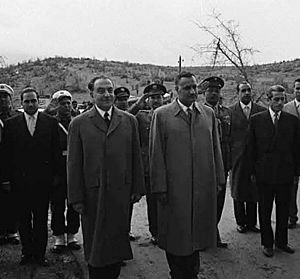
On 14 July 1958, army officers in Iraq overthrew the Iraqi monarchy. The Iraqi prime minister, a main opponent of Nasser, was killed. Nasser recognized the new government. The next day, US marines landed in Lebanon and British forces in Jordan. This was to prevent them from falling to pro-Nasser forces. Nasser felt the Iraqi revolution opened the way for Arab unity. He said he wanted full Arab union, but had no plan to merge Iraq with the UAR. However, the new Iraqi leader wanted Iraq to remain independent.
In late 1958, Nasser formed a committee to oversee Syria. He moved two Syrian leaders to Cairo, reducing their influence. He put Syria under a strict leader who made it like a police state. This leader imprisoned landowners who opposed Egyptian land reform. After new elections in Lebanon, relations with the UAR improved. In March 1959, Nasser and the Lebanese president met and ended the Lebanese crisis.
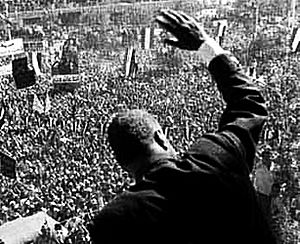
Relations between Nasser and the Iraqi leader became very bad. This was after Iraqi forces stopped a rebellion by a pro-Nasser officer. Nasser considered sending troops but decided against it. He cracked down on Egyptian communists because Iraqi communists supported the Iraqi leader. Several important communists were arrested.
By December, the political situation in Syria was getting worse. Nasser appointed Amer as governor-general. Syrian leaders opposed this, and many resigned. Nasser met with them and told them he was the elected president.
The Collapse of the Union
Some important groups in Syria opposed the union. These included wealthy people, politicians, and military leaders. Syria's economy was struggling. Nasser blamed this on the wealthy class. In July 1961, Nasser introduced socialist measures. These took control of many parts of the Syrian economy. He also dismissed the Syrian leader in September to calm the crisis. Nasser found it hard to solve Syria's problems because they were new to him. In Egypt, the economy was doing better, with industry growing fast. In 1960, Nasser took control of the Egyptian press. He wanted it to focus on economic issues and support his socialist plans.
On 28 September 1961, army units in Damascus launched a coup. They declared Syria's separation from the UAR. Pro-union army units in northern Syria revolted. Pro-Nasser protests happened in Syrian cities. Nasser sent Egyptian special forces to Latakia to help his allies. But he pulled them out two days later. He said he did not want fighting between Arab countries. On 5 October, Nasser accepted responsibility for the UAR's breakup. He said Egypt would recognize an elected Syrian government. He privately blamed other Arab governments for interfering. After the union ended, Nasser's health got worse.
Nasser's Return to Regional Leadership
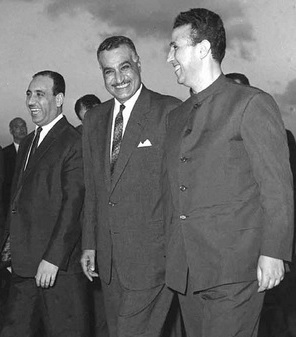
Nasser's regional standing changed when Yemeni officers overthrew the Imam of North Yemen on 27 September 1962. The Imam's supporters received help from Saudi Arabia. Nasser agreed to help the new Yemeni government militarily. Egypt became deeply involved in the North Yemen Civil War. By March 1966, 60,000 Egyptian soldiers were in North Yemen. In August 1967, Nasser recalled 15,000 troops due to losses in the Six-Day War. Egypt fully withdrew its soldiers by the end of 1967. Nasser later said the intervention in Yemen was a "miscalculation."
In July 1962, Algeria became independent from France. Nasser had strongly supported Algeria's independence movement. He saw it as a personal victory. In early 1963, some Saudi princes and the Jordanian chief of staff defected to Egypt.
On 8 February 1963, a military coup in Iraq overthrew the Iraqi leader. A Nasserist, Abdel Salam Aref, became the new president. A similar coup overthrew the Syrian government on 8 March. On 14 March, the new Iraqi and Syrian governments asked Nasser for a new Arab union. Nasser criticized the Syrian Ba'athists for the UAR's split. He said he was the "leader of the Arabs." A unity agreement was signed in April. But it fell apart weeks later when Syrian Ba'athists removed Nasser's supporters from the army. Nasser then called the Ba'athists "fascists."

In January 1964, Nasser called for an Arab League summit in Cairo. He wanted a unified Arab response to Israel's plans to divert the Jordan River's waters. Nasser blamed Arab divisions for the "disastrous situation." He told Syria and Palestinian fighters not to provoke Israel. He admitted he had no plans for war with Israel. During the summit, Nasser improved relations with King Hussein of Jordan and other Arab rulers. In May, Nasser helped create the Palestine Liberation Organization (PLO). He used the PLO to control Palestinian fighters.
Nasser, along with leaders from Indonesia, Yugoslavia, and India, founded the Non-Aligned Movement (NAM) in 1961. Its goal was to promote peace, end colonialism, and increase cooperation among developing countries. In 1964, Nasser became president of the NAM.
Nasser also played a big role in strengthening African unity in the late 1950s and early 1960s. Egypt became a safe place for anti-colonial leaders from African countries. Cairo broadcasted anti-colonial messages. Nasser helped in talks that led to the creation of the Organisation of African Unity (OAU) in 1963.
Modernizing Egypt and Internal Issues
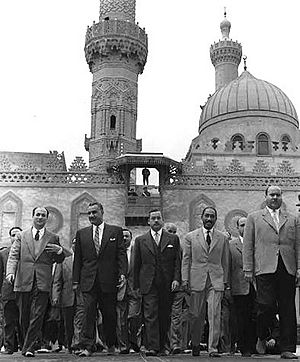
Changes at Al-Azhar University
In 1961, Nasser wanted Egypt to be the leader of the Arab world. He also wanted to combine Islamic and socialist ideas in Egypt. To do this, he made changes to al-Azhar University. This university is a leading authority in Sunni Islam. Nasser wanted to make sure it was more important than the Muslim Brotherhood.
Nasser told al-Azhar to change its courses. This led to coeducational schools and teaching evolution. The reforms also combined religious and civil courts. Nasser also made al-Azhar issue a religious ruling (fatwā). This ruling said that Shia Muslims, Alawites, and Druze were part of mainstream Islam. Before this, al-Azhar had called them "heretics."
Challenges with Amer
After Syria left the union, Nasser worried about Amer's leadership of the army. Amer had created a powerful group within the military and intelligence. In late 1961, Nasser tried to control military appointments. He wanted promotions to be based on skill, not personal loyalty. But Amer's allies in the army threatened to act against Nasser. Nasser backed down, avoiding a conflict.
In early 1962, Nasser tried again to take control of the military from Amer. Amer directly challenged Nasser and gathered his loyal officers. Nasser gave in again, fearing a fight between the military and his government. The stress from the UAR's collapse and Amer's growing power made Nasser's health worse. He had diabetes and started taking a lot of painkillers.
The National Charter and Second Term
In October 1961, Nasser started a big nationalization program in Egypt. He believed that fully adopting socialism would solve Egypt's problems. He thought it would have prevented Syria from leaving the union. To strengthen his support among Egyptians, Nasser introduced the National Charter in 1962. He also created a new constitution. The charter called for universal health care, affordable housing, and more rights for women. It also included a family planning program and plans to widen the Suez Canal.
Nasser also tried to manage the country's civil service. He wanted to prevent it from growing too large and becoming a burden. New laws gave workers a minimum wage, shares of profits, free education, and free health care. Working hours were reduced, and workers were encouraged to help manage businesses. Land reforms helped farmers, increased agricultural growth, and reduced poverty in rural areas. After these changes in 1962, the government owned 51% of Egyptian businesses. The National Union was renamed the Arab Socialist Union (ASU).
These changes also brought more control. Thousands of Islamists were imprisoned, including military officers. Nasser's move towards a Soviet-style system led some of his aides to resign in protest. During the presidential vote, Nasser was re-elected for a second term as UAR president. He was the only candidate. His political opponents were not allowed to run. In the same year, Nasser had a Muslim Brotherhood leader imprisoned. This leader was found guilty of plotting to kill Nasser and was executed in 1966. By 1966, Egypt's economy slowed down. Government debt became a problem. Nasser began to reduce state control over private businesses. He encouraged banks to lend to private businesses and offered incentives for exports. During the 1960s, Egypt's economy struggled, and freedoms decreased. Nasser's popularity also went down.
The Six-Day War
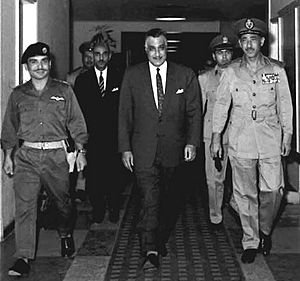
In mid-May 1967, the Soviet Union warned Nasser that Israel might attack Syria. However, Nasser's Chief of Staff thought these warnings were false. Amer, without Nasser's full approval, sent troops to Sinai on 14 May. Nasser then demanded that the UN emergency force leave. Nasser also received a warning from King Hussein of Jordan. Hussein said Israel and America were working together to draw Egypt into war. Nasser still believed the US would stop Israel from attacking. He also told the US and Soviet Union that Egypt would only defend itself.
On 21 May, Amer asked Nasser to block the Straits of Tiran. Nasser thought Israel would see this as a reason for war. Amer assured him the army was ready. But Nasser doubted Amer's assessment. Nasser knew that Amer's chosen officers were not very good. Still, Nasser thought Egypt could hold off Israeli forces for at least two weeks. This would allow time for diplomacy. Israel had said in 1957 that closing the Straits would be an act of war. But Nasser closed them to Israeli shipping on 22–23 May. By the end of May, Nasser felt war was unavoidable. On 26 May, Nasser declared, "our basic objective will be to destroy Israel." On 30 May, King Hussein of Jordan joined an alliance with Egypt and Syria.
On the morning of 5 June, the Israeli Air Force attacked Egyptian airfields. They destroyed much of Egypt's air force. By the end of the day, Israeli forces had broken through Egyptian lines. The next day, Amer ordered Egyptian troops to withdraw from Sinai. This caused most of Egypt's casualties during the war. Israel quickly captured Sinai and the Gaza Strip from Egypt. They also took the West Bank from Jordan and the Golan Heights from Syria.
Nasser realized how serious the situation was when Israelis cut off an Egyptian army group. He rushed to army headquarters. The conflict between Nasser and Amer became very clear. Officers present said they had a "nonstop shouting match." The committee overseeing the war blamed the defeats on the Nasser–Amer rivalry and Amer's poor leadership. An Egyptian diplomat later said the defeat was because Nasser ignored facts and made bad decisions.
Resignation and Its Aftermath
For the first four days of the war, Arabs believed their radio stations that they were winning. On 9 June, Nasser appeared on television. He told Egyptians about their country's defeat. He announced his resignation later that day. He gave all presidential powers to his Vice President, Zakaria Mohieddin. Mohieddin had not known about this decision and refused the job. In this speech, the Six-Day War was first called the "setback" (naksa).
Hundreds of thousands of supporters protested in the streets. They chanted, "We are your soldiers, Gamal!" Nasser took back his resignation the next day.
On 11 July, Nasser replaced Amer as military commander. Amer's loyal officers protested. After Nasser fired thirty of them, Amer and his allies planned to overthrow him on 27 August. Nasser found out about the plot. He convinced Amer to meet him on 24 August. Nasser confronted Amer, who denied the plot. Amer was then arrested. Amer died on 14 September. Nasser later said he lost "the person closest to [him]." After this, Nasser began to remove military figures from politics. He arrested many military and intelligence leaders loyal to Amer.
At the Arab League summit on 29 August, Nasser's power was less strong. The leaders expected Saudi King Faisal to lead. A ceasefire in the Yemen War was declared. The summit ended with the Khartoum Resolution. This resolution, according to one historian, left only one option: war with Israel.
The Soviet Union quickly sent new weapons to the Egyptian military. They also broke off relations with Israel. Nasser cut relations with the US after the war. In November, Nasser accepted UN Resolution 242. This resolution called for Israel to withdraw from territories taken in the war. His supporters said this was to buy time to prepare for another fight. His critics said it showed he was less interested in Palestinian independence.
Final Years as President
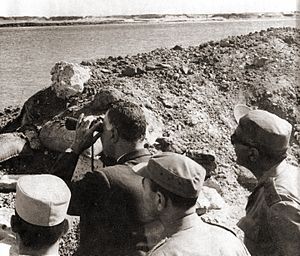
Domestic Changes and Government Shifts
Nasser took on more roles on 19 June 1967. He became prime minister and supreme commander of the armed forces. In February 1968, workers and students protested. They were angry about how lenient military courts were with air force officers after the 1967 war. Nasser responded by removing most military figures from his cabinet. He appointed eight civilians. He also told Egypt's intelligence to focus on outside threats, not internal spying. He declared the "fall of the mukhabarat state" (secret police state).
On 30 March, Nasser announced a plan for major political reforms. This included bringing back civil liberties and making parliament more independent. A public vote approved these changes in May. Elections were held for the highest decision-making body of the Arab Socialist Union (ASU). People saw this as a move towards more freedom, but many promises were not fully kept.
Nasser appointed Sadat and Hussein el-Shafei as his vice presidents in December 1969. By mid-1970, Nasser thought about replacing Sadat.
War of Attrition and Diplomacy
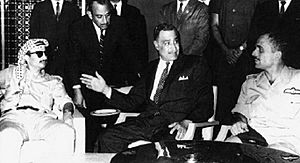
In January 1968, Nasser started the War of Attrition. He wanted to get back land taken by Israel. He ordered attacks on Israeli positions near the Suez Canal. In March, Nasser offered Yasser Arafat's Fatah movement weapons and money. He also advised Arafat to think about peace with Israel. He suggested creating a Palestinian state in the West Bank and Gaza Strip. Nasser effectively gave Arafat leadership over the "Palestine issue."
Israel responded to Egyptian attacks with raids and air strikes. This caused many civilians to leave Egyptian cities along the Suez Canal. Nasser stopped military activities and built new defenses. He received financial help from other Arab states. The war started again in March 1969. In November, Nasser helped make an agreement between the PLO and the Lebanese military. This allowed Palestinian fighters to use Lebanese territory to attack Israel.
In June 1970, Nasser accepted the US-backed Rogers Plan. This plan called for an end to fighting and Israeli withdrawal from Egyptian land. Israel, the PLO, and most Arab states rejected it. Nasser had initially rejected it too. But he agreed under pressure from the Soviet Union. He also thought a ceasefire could help him prepare to retake the Suez Canal. Nasser avoided direct talks with Israel. He often said that direct peace talks with Israel meant giving up. After Nasser accepted, Israel agreed to a ceasefire. Nasser used this time to move missiles closer to the canal zone.
Meanwhile, tensions grew in Jordan between the PLO and King Hussein's government. After some plane hijackings, a military campaign was launched to remove PLO forces. This raised fears of a regional war. Nasser called an emergency Arab League summit on 27 September in Cairo. There, he helped create a ceasefire.
Death and Funeral
The Arab League summit ended on 28 September 1970. Hours later, Nasser suffered a heart attack. He was taken to his home, where doctors tried to help him. Nasser died several hours later, around 6 p.m., at age 52. His doctor said the cause was likely hardening of the arteries, varicose veins, and complications from long-term diabetes. Nasser was also a heavy smoker. Two of his brothers died in their fifties from similar heart problems. The public did not know about Nasser's health issues before his death. He had had heart attacks in 1966 and 1969.
When Nasser's death was announced, most Arabs were in shock. His funeral procession through Cairo on 1 October was attended by at least five million mourners. The procession started at the old RCC headquarters. His coffin, covered with a flag, was pulled by six horses. All Arab leaders attended, except the King of Saudi Arabia. King Hussein and Yasser Arafat cried openly. Muammar Gaddafi of Libya fainted twice from sadness. Some important non-Arab leaders were also there.
As the procession began, mourners surrounded Nasser's coffin. They chanted, "There is no God but Allah, and Nasser is God's beloved." Police tried to control the crowds but could not. Most foreign leaders had to be evacuated. The procession ended at the Nasr Mosque, which was later renamed Abdel Nasser Mosque, where he was buried.
People across the Arab world wept and wailed after hearing of his death. Over a dozen people were killed in Beirut due to the chaos. In Jerusalem, about 75,000 Arabs marched, chanting, "Nasser will never die." A Lebanese newspaper headline read, "One hundred million human beings—the Arabs—are orphans." This showed how much he was seen as the leader of the Arab people.
Gamal Abdel Nasser's Legacy

Nasser made Egypt fully independent from British influence. Under his leadership, Egypt became a major power among developing nations. One of his main goals was to create social justice. During his presidency, ordinary citizens had better access to housing, education, jobs, and health services. The power of wealthy landowners decreased.
However, these gains came with less freedom. In Nasser's Egypt, the media was controlled. Mail was opened, and phones were listened to. He was elected president in 1956, 1958, and 1965. In these elections, he was the only candidate. He always claimed almost unanimous support. The parliament mostly just approved Nasser's policies. Nasser held almost all the power in the country.
By the end of his presidency, jobs and working conditions had improved a lot. But poverty was still high. Many resources meant for social welfare went to the war effort.
The economy grew significantly through land reform and big projects like the Helwan steel works and the Aswan Dam. Taking control of the Suez Canal also helped. However, strong economic growth in the early 1960s slowed down later in the decade. Egypt had a "golden age" of culture during Nasser's time. This included film, television, theater, and music. Egypt was a leader in these areas in the Arab world.
After Nasser, political parties inspired by him began to appear in Egypt. The first was the Arab Democratic Nasserist Party. These parties had little political power. Splits within them led to new parties. One such party, Al-Karama, was founded in 1997. Its leader came in third in the 2012 Egyptian presidential election. Nasserist activists also helped start Kefaya, a major opposition group. In 2012, four Nasserist parties merged to form the United Nasserist Party.
Public Image of Gamal Abdel Nasser
Nasser was known for being approachable and having a direct connection with ordinary Egyptians. He was available to the public, even after assassination attempts. This was unusual for leaders. He was a skilled speaker, giving many speeches during his time as president. Historians say Nasser was seen as truly representing Egypt. The national press also helped make him popular, especially after the government took control of the media.
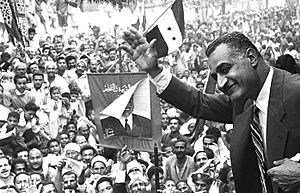
Even after the Six-Day War and his death, the public remained supportive of Nasser. Many Egyptians today feel a sense of "nostalgia for Nasser." This is especially true during times of difficulty. His presidency is remembered for national purpose, hope, and a lively culture.
Today, Nasser is still an iconic figure across the Arab world. He symbolizes Arab unity and dignity. He is also seen as a champion of social justice in Egypt. Time magazine wrote that despite his mistakes, Nasser gave Egyptians a sense of worth and national pride they had not known for centuries.
A historian wrote in 2013 that Nasser's time "still represents, for many, the last time that Egypt felt united." During the Arab Spring in 2011, pictures of Nasser were seen in protests in Cairo and other Arab cities. He became a "symbol of Arab dignity" during these demonstrations.
Criticisms of Gamal Abdel Nasser
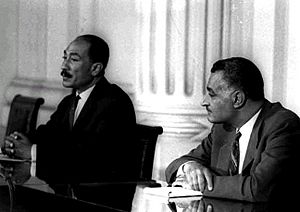
Anwar Sadat, who became president after Nasser, said he would "continue the path of Nasser." But he started to change Nasser's policies. He opened up Egypt's economy to private investment.
Some critics in Egypt saw Nasser as a dictator. They said he stopped democratic progress and imprisoned many people who disagreed with him. Islamists, especially from the Muslim Brotherhood, saw Nasser as oppressive. A liberal writer described Nasser as a "confused Sultan" who spoke well but had no real plan.
Some critics believed Nasser's popularity was due to his ability to manipulate the public. An Egyptian political scientist blamed Nasser's concentration of power for Egypt's lack of democracy. He also criticized Nasser's limits on freedom of expression.
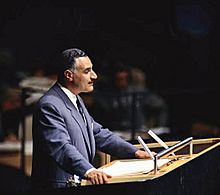
An American political scientist said Nasser's charisma meant he did not need other organizations or people to connect with Egyptians. He believed Nasser's legacy was "instability" because he relied on personal power, not strong political systems. Another historian wrote that Nasser was an irrational leader. He blamed Nasser's tendency to make decisions alone for Egypt's losses in the Suez War. A CIA officer who knew Nasser well said that Nasser became so isolated that he only heard information that supported his own views.
Zakaria Mohieddin, Nasser's vice president, said Nasser changed over time. He stopped asking his colleagues for advice and made more decisions by himself. Mohieddin suggested that Nasser's diabetes might have affected his actions in 1967.
Nasser also encouraged the spread of an antisemitic book called "The Protocols of the Elders of Zion." He believed that Jewish people had a lot of influence over global money and wanted to control the world. He also hired former Nazi officials to spread antisemitic ideas. However, he was considered more moderate than some other political groups at the time.
Regional Leadership
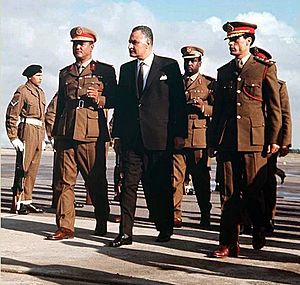
Nasser's actions and speeches inspired several nationalist revolutions in the Arab world. He shaped the politics of his generation. He spoke directly to the Arab public, bypassing other leaders. This was a unique achievement. Because Nasser was so central, new Arab nationalist leaders wanted good relations with Egypt. This helped them gain support from their own people.
Nasser's system of government, where the state controlled much, was copied by almost all Arab republics. These included Algeria, Syria, Iraq, and Libya. Algeria's first president was a strong supporter of Nasser. The leader who overthrew the king of North Yemen did so in the name of Nasser's pan-Arabism. Other coups influenced by Nasser happened in Iraq in 1958 and Syria in 1963. Muammar Gaddafi, who overthrew the Libyan monarchy in 1969, saw Nasser as his hero. He wanted to be the next "leader of the Arabs." Also in 1969, a supporter of Nasser took power in Sudan. The Arab Nationalist Movement helped spread Nasser's pan-Arab ideas throughout the Arab world.
Personal Life
In 1944, Nasser married Tahia Kazem (1920–1992). She was the daughter of a wealthy Iranian father and an Egyptian mother. Nasser met her through her brother. After their wedding, they moved into a house in Cairo. They lived there for the rest of their lives. Nasser's military job gave him a good income. Nasser and Tahia sometimes talked about politics. But mostly, Nasser kept his work separate from his family life. He liked to spend his free time with his children.
Nasser and Tahia had two daughters and three sons:
- Hoda, born 1945
- Mona, born 1947
- Khalid, (1949–2011). He was the most politically active. He was accused of being involved in assassinations of Israeli agents in the late 1980s. Khalid took refuge in Yugoslavia and was later pardoned.
- Abd al-Hamid, born 1951
- Abd al-Hakim, born 1955. He often appears in Egyptian media and leads the museum about his father.
Nasser was a Muslim who followed his faith. He made the Hajj pilgrimage to Mecca in 1954 and 1965. He was known for being honest and not taking bribes. This helped his reputation. Nasser enjoyed playing chess, watching American films, reading magazines, and listening to classical music.
Nasser smoked heavily. He worked 18-hour days and rarely took vacations. This combination contributed to his poor health. He was diagnosed with diabetes in the early 1960s. By the time he died, he also had heart disease and high blood pressure. He had two major heart attacks in 1966 and 1969. State media said his absence from public view was due to the flu.
Writings
Nasser wrote the following books:
- Memoirs of the First Palestine War (1955)
- Egypt's Liberation: The Philosophy of the Revolution (1955)
- Towards Freedom (1959)
Honours
 Czechoslovakia:
Czechoslovakia:
 Finland:
Finland:
 Malaysia:
Malaysia:
 Polish People's Republic:
Polish People's Republic:
 South Africa:
South Africa:
 Soviet Union:
Soviet Union:
 Tunisia:
Tunisia:
 Yugoslavia:
Yugoslavia:
See also
 In Spanish: Gamal Abdel Nasser para niños
In Spanish: Gamal Abdel Nasser para niños
- History of Egypt under Gamal Abdel Nasser
- List of prime ministers of Egypt
- Six-Day War
- Closure of the Suez Canal (1967–1975)



